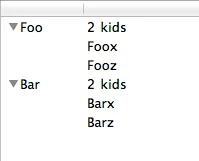请问,您能否提供一个简单完整的Cocoa应用程序示例,其中包含带有分层数据表示的NSOutlineView,不像NSOutlineView和NSTreeController示例那样模棱两可。
谢谢!
谢谢!
这个例子使用一个简单的双层次结构,其中有两个父节点Foo和Bar,它们各自有两个子节点,分别为Foox,Fooz以及Barx,Barz。轮廓视图是默认视图,只有两列,并且第二列的标识符设置为“children”。
NSDictionary *firstParent = @{@"parent": @"Foo", @"children": @[@"Foox", @"Fooz"]};
NSDictionary *secondParent = @{@"parent": @"Bar", @"children": @[@"Barx", @"Barz"]};
NSArray *list = @[firstParent, secondParent];
- (BOOL)outlineView:(NSOutlineView *)outlineView isItemExpandable:(id)item
{
if ([item isKindOfClass:[NSDictionary class]]) {
return YES;
}else {
return NO;
}
}
- (NSInteger)outlineView:(NSOutlineView *)outlineView numberOfChildrenOfItem:(id)item
{
if (item == nil) { //item is nil when the outline view wants to inquire for root level items
return [list count];
}
if ([item isKindOfClass:[NSDictionary class]]) {
return [[item objectForKey:@"children"] count];
}
return 0;
}
- (id)outlineView:(NSOutlineView *)outlineView child:(NSInteger)index ofItem:(id)item
{
if (item == nil) { //item is nil when the outline view wants to inquire for root level items
return [list objectAtIndex:index];
}
if ([item isKindOfClass:[NSDictionary class]]) {
return [[item objectForKey:@"children"] objectAtIndex:index];
}
return nil;
}
- (id)outlineView:(NSOutlineView *)outlineView objectValueForTableColumn:(NSTableColumn *)theColumn byItem:(id)item
{
if ([[theColumn identifier] isEqualToString:@"children"]) {
if ([item isKindOfClass:[NSDictionary class]]) {
return [NSString stringWithFormat:@"%i kids",[[item objectForKey:@"children"] count]];
}
return item;
}else{
if ([item isKindOfClass:[NSDictionary class]]) {
return [item objectForKey:@"parent"];
}
}
return nil;
}

使用NSURL和Swift的NSOutlineView简单示例,填充目录结构。
AppDelegate.swift
import Cocoa
@NSApplicationMain
class AppDelegate: NSObject, NSApplicationDelegate {
var mainWindowController: MainWindowController?
func applicationDidFinishLaunching(aNotification: NSNotification) {
// Insert code here to initialize your application
let mainWindowController = MainWindowController()
mainWindowController.showWindow(self)
self.mainWindowController = mainWindowController
}
func applicationWillTerminate(aNotification: NSNotification) {
// Insert code here to tear down your application
}
func applicationShouldTerminateAfterLastWindowClosed(sender: NSApplication) -> Bool {
return true
}
}
FileItem.swift
class FileItem {
var url: NSURL!
var parent: FileItem?
var isLeaf:Bool = false
static let fileManager = NSFileManager.defaultManager()
static let requiredAttributes = [NSURLIsDirectoryKey]
static let options: NSDirectoryEnumerationOptions = [.SkipsHiddenFiles, .SkipsPackageDescendants, .SkipsSubdirectoryDescendants]
lazy var children: [FileItem]? = {
if let enumerator = fileManager.enumeratorAtURL(self.url, includingPropertiesForKeys:FileItem.requiredAttributes, options: FileItem.options, errorHandler: nil) {
var files = [FileItem]()
while let localURL = enumerator.nextObject() as? NSURL {
do {
let properties = try localURL.resourceValuesForKeys(FileItem.requiredAttributes)
// check this
files.append(FileItem(url: localURL, parent: self, isLeaf: (properties[NSURLIsDirectoryKey] as! NSNumber).boolValue))
} catch {
print("Error reading file attributes")
}
}
return files
}
return nil
}()
init(url: NSURL, parent: FileItem?, isLeaf: Bool){
self.url = url
self.parent = parent
self.isLeaf = isLeaf
}
var displayName: String {
get {
return self.url.lastPathComponent!
}
}
var count: Int {
return (self.children?.count)!
}
func childAtIndex(n: Int) -> FileItem? {
return self.children![n]
}
}
import Cocoa
class MainWindowController: NSWindowController {
@IBOutlet weak var outline: NSOutlineView!
private var rootItem: FileItem? = FileItem(url: NSURL(fileURLWithPath:"/"), parent: nil, isLeaf: true)
override func windowDidLoad() {
super.windowDidLoad()
// Implement this method to handle any initialization after your window controller's window has been loaded from its nib file.
}
override var windowNibName: String? {
return "MainWindowController"
}
}
//MARK: - NSOutlineViewDelegate
extension MainWindowController: NSOutlineViewDelegate {
func outlineView(outlineView: NSOutlineView, viewForTableColumn tableColumn: NSTableColumn?, item: AnyObject) -> NSView? {
let view = outline.makeViewWithIdentifier("TextCell", owner: self) as? NSTableCellView
if let it = item as? FileItem {
if let textField = view?.textField {
textField.stringValue = it.displayName
}
} else {
if let textField = view?.textField {
textField.stringValue = self.rootItem!.displayName
}
}
return view
}
}
//MARK: - NSOutlineViewDataSource
extension MainWindowController: NSOutlineViewDataSource {
func outlineView(outlineView: NSOutlineView, child index: Int, ofItem item: AnyObject?) -> AnyObject {
if let it = item as? FileItem {
return it.childAtIndex(index)!
}
return rootItem!
}
func outlineView(outlineView: NSOutlineView, numberOfChildrenOfItem item: AnyObject?) -> Int {
if let it = item as? FileItem {
return it.count
}
return 1
}
func outlineView(outlineView: NSOutlineView, isItemExpandable item: AnyObject) -> Bool {
if let it = item as? FileItem {
if it.count > 0 {
return true
}
}
return false
}
}
这里有一个示例 OutlineView
这是这个示例的修改版本 NSOutlineViewInSwift
func outlineView(outlineView: NSOutlineView, child index: Int, ofItem item: AnyObject?) -> AnyObject is a method in NSOutlineViewDataSource, not NSOutlineViewDelegate - YangXiaoyu